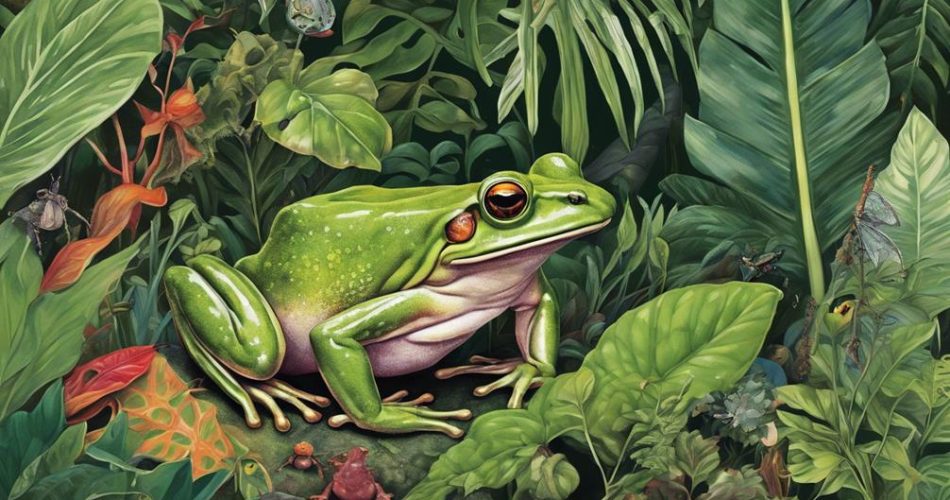Although it's hard to imagine a frog the size of a baby, the Goliath Frog is exactly that, easily dwarfing its amphibian counterparts. You'd think this incredible creature, which can leap over 10 feet in a single bound and weigh up to 7 pounds, would be a common topic of discussion, but it's surprisingly unknown.
Just wait till you uncover its unusual breeding habits, unique diet, and intriguing habitat. Intrigued? Well, hold on, because we're just getting started.
Key Takeaways
- Goliath Frogs, the largest frog species, can reach a whopping 32 cm in length and weigh up to 3.3 kg.
- Unique among frogs, they build nests using their hind limbs and males guard the nests after egg-laying.
- Despite lacking a tongue, they feed on large prey like bats and small turtles, using their powerful jaws.
- With their habitat limited to the rainforests of Cameroon and Equatorial Guinea, habitat destruction and poaching pose serious threats to their survival.
The Goliath Frog's Grand Size
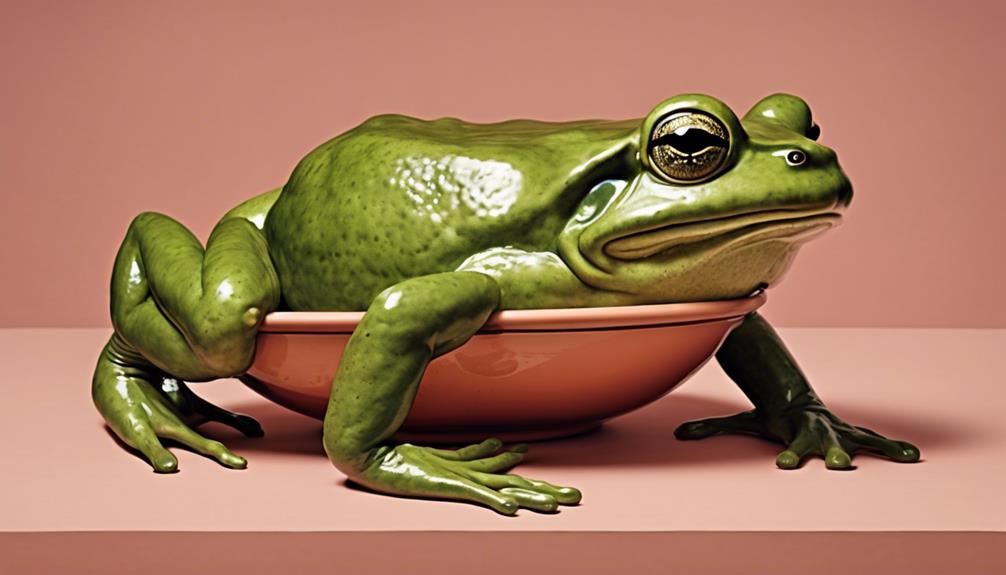
Dwarfing its amphibian counterparts, the Goliath Frog impresses with its astonishing size, reaching up to 32 cm in length and weighing as much as a newborn baby at around 3.3 kg. When you compare this size to other species in the frog family, such as the tiny 7.7 mm Paedophryne amauensis, the Goliath Frog's enormity is truly remarkable.
However, what's more fascinating is the growth rate of these amphibians. Unlike other frogs, which stop growing once they become adults, Goliath Frogs never stop growing. They continue to increase in size throughout their lifespan, which can last up to 15 years in the wild. Their continuous growth rate is a unique attribute that significantly contributes to their massive size.
In the realm of amphibians, the Goliath Frog's size is an interesting anomaly. It's a stark contrast to the average frog, which ranges between 1.5 to 10 cm in length. This comparison highlights the fascinating diversity within the amphibian world, from the smallest frog species to the largest. The Goliath Frog's size and growth rate serve as intriguing areas of study for biologists and herpetologists alike, providing valuable insights into the varied adaptations and survival strategies of different species.
Unusual Breeding Habits
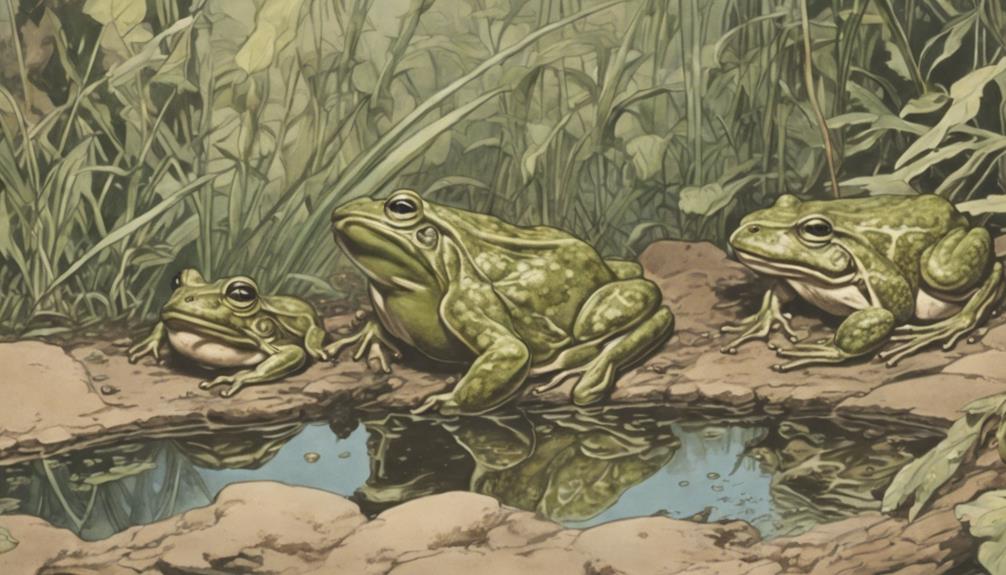
Apart from their impressive size, Goliath Frogs also exhibit some distinct and intriguing breeding habits that set them apart from other amphibian species. Their nesting construction is an evident display of their unusual behavior. Unlike typical frogs, Goliaths engage in complex nest-building techniques, using their powerful hind limbs to shift rocks and clear debris from riverbeds. They meticulously create these nests in shallow water bodies, ensuring optimal conditions for the eggs they'll lay.
Their parental care patterns are equally fascinating. After the females lay their eggs, the males assume the role of protector, diligently guarding the nests. This vigilant approach to parental care isn't common among other frog species, further highlighting their distinctiveness.
However, it's crucial to note that Goliath Frogs don't engage in active feeding of the tadpoles, a behavior common in some other amphibians. Their care ends at nest protection, leaving the young to fend for themselves post-hatching.
The Frog's Unique Diet
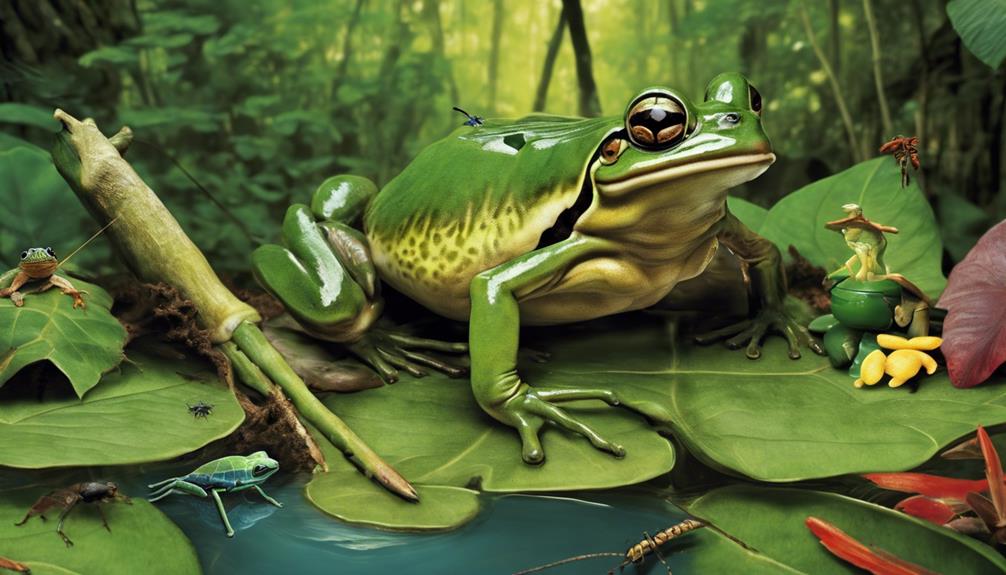
While their breeding habits are undoubtedly intriguing, the Goliath Frog's diet is equally distinctive, constituting a crucial part of their unique biology. This gigantic amphibian has undergone fascinating dietary adaptations over time, particularly in terms of prey selection. They're not fussy eaters, but they do have a preference for certain types of food.
This species primarily feeds on insects, crustaceans, fish, and other small invertebrates. They've been known to consume bats and even small turtles. Their large size allows them to overpower and consume prey that would be too large for other frog species. Interestingly, Goliath Frogs don't possess a tongue, a trait common amongst their kin, which forces them to use their powerful jaws to catch and consume prey.
One of the most fascinating aspects of the Goliath Frog's diet is its apparent preference for natural, live prey. They've shown a lack of interest in dead or artificial food sources. This preference for live food may be a result of their need for certain nutrients found only in live prey, or it may be a simple behavioural trait. Regardless, it's clear that the Goliath Frog's diet is a fascinating topic in its own right.
Habitat and Geographic Distribution
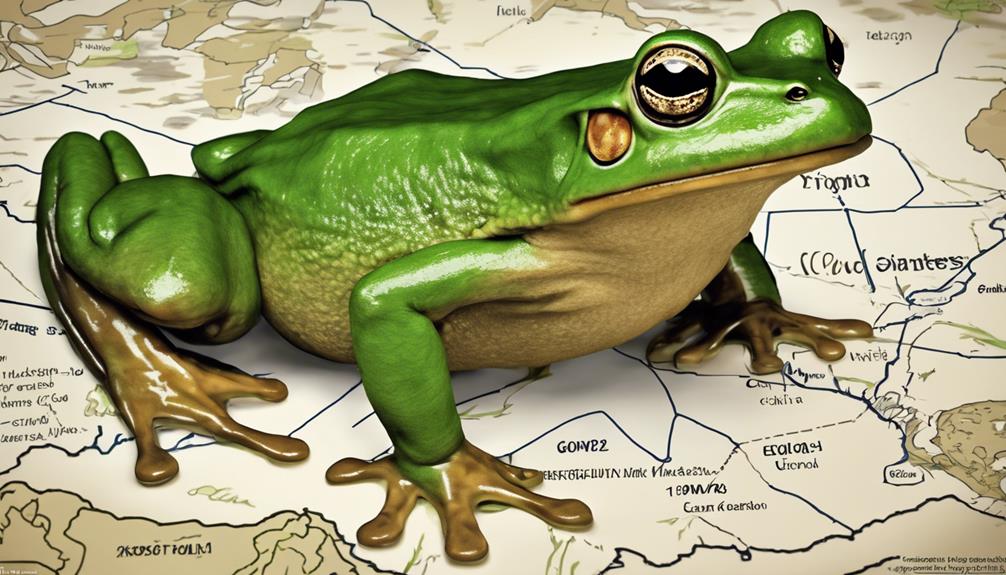
If you were to embark on a journey to find the Goliath Frog in its natural habitat, you'd find yourself exploring the dense, humid rainforests of western central Africa, specifically in Cameroon and Equatorial Guinea. These amphibians aren't widespread across the African continent, but rather, they're confined to a relatively small geographic range, showcasing the specificity of their habitat needs.
Now, let's dive into the intricacies of their river adaptations. You'd be intrigued to know that the Goliath Frog is a truly aquatic species. It has evolved to thrive in swift-flowing rivers and streams, utilizing its powerful hind legs and webbed feet to navigate against strong currents. The rivers' rocky bottoms provide ideal breeding grounds, where the males construct nesting sites by moving large stones.
The Goliath Frog is uniquely adapted to the African ecosystems it inhabits – ecosystems that are characterized by high humidity, heavy rainfall, and dense forest canopies providing shade. These conditions are critical for the amphibian's skin, which requires constant moisture. The frogs are particularly active at night, taking advantage of the cooler temperatures and reduced predation risks. This nocturnal behavior is a key adaptation for survival within their ecosystem.
Conservation Status and Threats
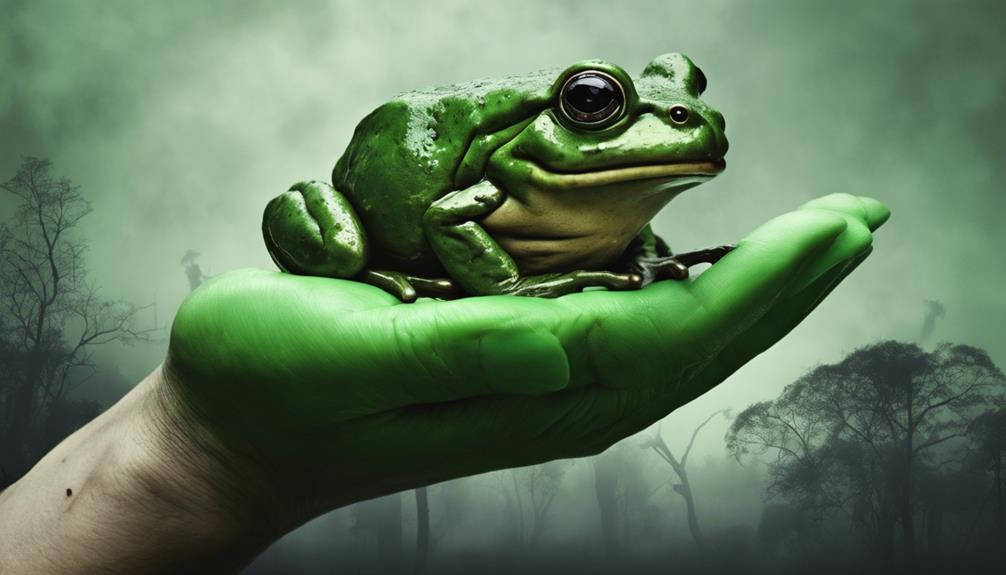
Despite the Goliath Frog's unique adaptations to its specific ecosystem, it faces major conservation challenges that threaten its survival. The primary threats to this species are habitat destruction and poaching. Uncontrolled deforestation and construction activities are causing significant loss of its natural habitat, shrinking the spaces where it can thrive. This habitat loss is a direct effect of human activities and it's pushing these amphibians towards the brink of extinction.
Poaching Impact on the Goliath Frog is also significant. Due to their size and unique nature, these frogs are often caught and sold as exotic pets or used for bushmeat. This illegal trade is a severe threat, further diminishing their already dwindling population.
Protective Measures are urgently needed to safeguard this species. Many conservation organizations are working to prevent its extinction by preserving its habitat, enforcing strict anti-poaching laws, and raising awareness about the importance of the Goliath Frog to its ecosystem.
Here's a summary of the threats and measures:
| Threats | Measures |
|---|---|
| Habitat Destruction | Habitat Preservation |
| Poaching | Strict Anti-Poaching Laws |
| Low Awareness | Education and Advocacy |
| Illegal Trade | Law Enforcement |
| Population Decline | Breeding Programmes |
Your understanding and support in these conservation efforts can make a difference.
Frequently Asked Questions
What Is the Average Lifespan of a Goliath Frog?
You're curious about the average lifespan of a goliath frog. In general, these frogs can live up to 15 years in captivity. Factors like the frog's aging process and various lifespan influences such as diet, environment, and predation can affect this.
However, it's more challenging to determine their lifespan in the wild due to these variables. These giants of the frog world are truly fascinating, aren't they?
Are Goliath Frogs Dangerous or Harmful to Humans?
No, goliath frogs aren't dangerous or harmful to humans. They're typically shy creatures that prefer to avoid human interaction.
However, like all wildlife, they should be handled with care to prevent stress or injury. Their diet, consisting mostly of insects and small crustaceans, doesn't pose any threat to humans.
Always remember proper frog handling precautions when interacting with these fascinating creatures.
How Do Goliath Frogs Communicate With Each Other?
You might find it fascinating that goliath frogs communicate with each other using distinct frog vocalizations. These communication methods are crucial for everything from mating rituals to warding off potential threats.
Unfortunately, due to their size, they can't produce the typical croaking sounds. Instead, they use a kind of physical signaling, like body movements, to communicate.
How Has the Goliath Frog Adapted to Its Environment Over Time?
You're wondering how the Goliath frog has adapted over time. Through evolutionary changes, it's developed unique frog survival techniques.
It's grown incredibly large, up to 32 cm, to deter predators. It's also developed the ability to stay underwater for long periods, enabling it to escape threats.
Additionally, these frogs have strong hind legs for powerful leaps and fast swimming, crucial for both catching prey and evading danger. Evolution has certainly equipped the Goliath frog for survival.
What Is the Speed of a Goliath Frog When It Jumps or Swims?
You're curious about the speed of a Goliath frog, both when jumping and swimming.
Studying their jumping mechanics, they can leap up to 10 feet in a single bound.
When it comes to swimming techniques, they're quite efficient and speedy, but exact speeds aren't documented.
They adapt their movements to fit their environment, ensuring they're quick when escaping predators or catching prey.
There's still much to learn about these fascinating creatures.
Conclusion
You've just delved into the world of the Goliath frog, the largest frog species on earth. You've discovered its unusual breeding habits, unique diet, and wide geographic distribution.
You've also learned about its precarious conservation status and the threats it faces. Armed with this knowledge, you can appreciate the remarkable resilience of these frogs and understand the urgent need to protect them.
Every creature, no matter how small or large, plays a vital role in our planet's biodiversity.


